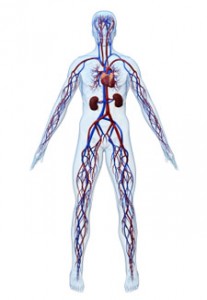Poor Circulation | Diagnosis and Treatment
Poor Circulation: Artery, Vein, & Lymphatic Diseases

What defines circulation? Circulation is the movement of blood through the arteries and veins throughout the body. This movement is induced by the pumping action of the heart and the continuous movement of vein valves within the venous circulation. Circulation can also refer to the movement lymph fluid through an often neglected part of the circulatory system, the lymphatic system. Any time that there is diminished flow in the arteries or the veins as a result of vascular disease, then it is referred to as poor circulation.
Poor circulation refers to the dysfunction of the cardiovascular system blood and lymph flow as a result of cardiovascular or lymphatic disease. This poor circulation disease can involve the heart, arteries, veins, lymphatic system, or the blood itself. The blood is composed of red blood cells, white blood cells, platelets, and plasma. Dysfunction or disease of any of these structures or components can lead to poor circulation.
Common Types of Poor Circulation
One of the most common types of poor circulation results from heart dysfunction. Heart dysfunction most frequently results from buildup of cholesterol and lipid plaque within the coronary arteries of the heart. This process is referred to as coronary artery disease or coronary atherosclerosis. This is the most common cause of heart attacks (myocardial infarction). A heart attack is damage to the heart muscle itself as a result of diminished flow to the heart muscle. This typically results from buildup of plaque or clot within the coronary arteries. Other types of heart dysfunction can result from faulty or damages heart valves that lead to diminishes flow or ejection of blood from the heart. Other types of diseases of the heart, such as cardiomyopathies, results from direct damage to the heart muscle from viruses, drugs, or systemic diseases such as diabetes.
Peripheral Artery Disease PAD
Another common type of poor circulation involves the remainder of the arteries throughout the body. Arteries are the conduits to deliver oxygenated blood and nutrients to all of the organs and extremities of the body. When these arteries are diseased, it most commonly results from atherosclerotic plaque build-up within the vessel lumen. This plaque then hinders the flow of oxygen rich blood to the tissues. The tissues and organs then begin to get damaged as the results of poor blood flow.
The most common type of non-cardiac arterial disease that requires treatment is peripheral artery disease of the legs. “Peripheral” just refers to the periphery of the body, i.e. the arms and legs. The legs are the organ or structure that is the farthest from the heart. The legs often have difficulty getting adequate blood flow from the heart as the leg arteries get diseased. When the arteries of the extremities (legs or arms) are affected by plaque build-up or atherosclerosis, it is called Peripheral Artery Disease or PAD. Arteriosclerosis is another medical term that is used interchangeably to describe PAD. Conditions that can cause build-up of plaque are aging, poor diet, smoking, sedentary lifestyle, high cholesterol, high triglycerides / lipids, and certain diseases such as diabetes. There can also be strong genetic predisposition for premature or more aggressive hardening of the arteries.
When people develop poor circulation of the legs (peripheral artery disease / PAD), then often begin developing symptoms in their legs of feet. This can include pain in the lower legs or calves / calf during walking. This “walking pain” is referred to by the medical term claudication. Other problems can include pain even at rest or when the legs are elevated, referred to as “rest pain.” Rest pain from poor circulation can occur in the legs or feet. Poor circulation from PAD can also lead to numbness, tingling, neuropathy, or weakness in the arms or legs. In the worse or advanced cases of peripheral artery disease, people can develop wounds or ulcers of the toes, feet, ankles, or legs. These wounds are often painful, get easily infected, and are slow or impossible to heal. If the wounds progress to an advanced state it can lead to gangrene (blackening and death of the tissues).
Another form of peripheral artery disease results from blood clots developing within an artery or arteries. Any artery in the body can develop a blood clot. When an artery clot develops it can threaten both life and limb. Blood clots in arteries can lead to sudden death, cardiac arrest, stroke, and gangrene / failure of an organ, arm, or leg. Artery blood clots are referred to as “arterial thrombosis” or artery thromboembolism by medical personnel. Artery blood clots are extremely dangerous. When an artery blood clot develops there is usually severe pain in the area of the clot or in the area of the body that would otherwise be supplied with blood by the clotted artery. Artery blood clots can usually be diagnosed with the use of duplex ultrasound. Sometimes a CT scan, MRI, or catheter angiogram may be required for diagnosis.
Less common forms of peripheral artery disease are artery dissections, adventitial cystic disease, popliteal entrapment syndrome, thoracic outlet syndrome, and peripheral artery aneurysms (iliac, femoral, and popliteal artery aneurysms). If you suspect PAD, contact our vascular center for assessment.
Peripheral Venous Disease PVD
Peripheral venous disease (PVD) also involves the peripheral circulation (the circulation of the arms or legs). Once again, just like peripheral artery disease, venous disease is usually most severe and most pronounced in the legs. The legs are the furthest from the heart, which is one of the primary reasons they are often most affected by venous disease. There are many types of peripheral venous disease (PVD) , which will be described below. Most of these diseases lead to leg pain and / or leg swelling, but they can also affect the arms.
Venous Reflux Disease
Varicose veins are the most common type of peripheral venous disease. Varicose veins most commonly result from dysfunctional or diseased vein valves inside the veins. When vein valves are diseased and faulty, then blood flow within the veins reverses directions or “refluxes.” This leads to venous engorgement and venous hypertension.
Normal veins return or recirculate de-oxygentated and nutrient deprived blood back to the heart. The veins have to combat gravity to get this blood back towards the heart. Unlike the arteries which have a heart pump to push the blood, the veins do not have much help from the heart. Rather, they have to constantly work to push the blood with the use of one-way vein valves. If these valves are weak or faulty, then the blood flow in the veins starts to pool and reverse direction, a process referred to as “venous reflux.” Venous reflux due to faulty veins valves leads to abnormal pressure buildup in the abnormal veins and in the tissues being supplied by the veins. As the pressure builds, the pressure begins to cause symptoms and tissue damage. This vein reflux disease can present as leg and foot pain, leg and foot swelling, leg and foot discoloration / skin damage, and visible varicose veins forming. Another term used to describe venous reflux disease is “chronic venous insufficiency.”
In the most severe cases of venous reflux, venous ulcers or wounds can develop. These venous wounds most commonly occur on the ankles or feet. These ulcers often occur spontaneously and are slow to heal.
Venous reflux disease also leads to the development of unsightly blue bulging veins at the skin surface, referred to as varicose veins. If you are suffering from varicose veins, see our dedicated vein website at: www.AustinVaricoseVein.com.
Blood Clots: DVT & SVT
Another form of poor circulation results from blood clots developing within arteries of veins. A clot is an abnormal accumulation of coagulated gelatinous blood within a blood vessel. The most common location of blood clots is the veins of the legs, pelvis, and arms. When the blood clots involve the larger and deeper veins of the body then the condition is referred to as DVT, which stands for Deep Venous Thrombosis. This DVT condition can result in the development of pain or swelling in an extremity. Discoloration of the skin, numbness, or weakness in an arm or leg could also occur. DVT blood clots are dangerous because the clots can break lose and travel to the hear or lungs, a process referred to as an embolism. Pulmonary embolism, also referred to as a PE, can be a lethal event. It can initially presents with shortness of breath / trouble breathing or chest pain, but it can also lead to sudden cardiac arrest and death. If you develop unexplained leg swelling, pain, or discoloration then you should promptly see a vein specialist and get evaluated with a venous duplex ultrasound to assess for clots.
When blood clots abnormally develop in smaller and more superficial veins of the body that are less important for body function, then the condition is referred to as SVT, or superficial venous thrombosis. The most common locations for SVT to develop is in leg varicose veins and at prior IV access sites in the arms. SVT usually lead to a focal area of pain, swelling, redness, firmness and / or tenderness in a leg or arm either just beneath the skin or within the skin itself. SVT can sometime progress and lead to the more serious DVT described above.
Other types of PVD include May-Thurner Syndrome, Thoracic Outlet Syndrome, and Post-Thrombotic Syndrome. If you suspect that you may have an DVT, SVT, or another form of PVD, then you should immediately contact a vein specialist for assessment.
Lymphedema
Another type of poor circulation is caused by lymphatic dysfunction. The lymphatic system is a portion of the immune system of the body that serves to fight infections and remove foreign subtances. Immune system cells and components are transported as fluid in the body that is referred to as lymph. Lymph fluid is physically a clear fluid that drains throughout the body through a network of small channels / tubes that are referred to as the lymphatic system. Most of these channels are very small, < 1 mm in diameter. These channels coalesce / join into lymph node basins that then filter the lymph fluid as it travels from one location of the body to the other. The complex network of lymphatic channels, lymphatic fluid, and lymph nodes makes up the lymphatic portion of the circulatory system.
When the lymphatic system is damaged as the result of some sort of disease or insult, then poor circulation can result. Some conditions that can lead to lymphatic damage and dysfunction are infections (lymphangitis), trauma, surgery, or cancers. Many cases of lymphatic dysfunction are unexplained and are referred to as “idiopathic.” When the lymphatic system is damaged, it typically will results in an increased risk of infection or cancer developing in the region of the damage.
Some of the most common areas of visible lymphatic dysfunction are the legs and the arms. When the lymphatics draining these areas are damaged by trauma, surgery, infection, or cancers, then the extremity / limb correlating to that area will often begin to swell progressively. There can often be discoloration of the skin or pain of the extremity involved as well. Recurrent infections can also develop due to inadequate immune system function. The resultant swelling of a limb is referred to as lymphedema. “Edema” refers to an abnormal collection of tissue fluid.
If you suspect that you may be developing lymphedema, then contact a vascular specialist for assessment and treatment.
If you suspect that you may have developed poor circulation, then contact our vascular specialists at (512) 339-9102. If the situation is acute or urgent, then go immediately to an emergency room for assessment.







